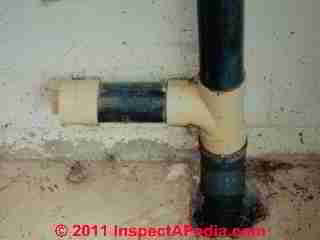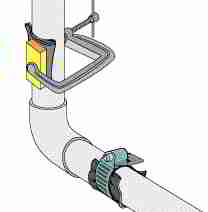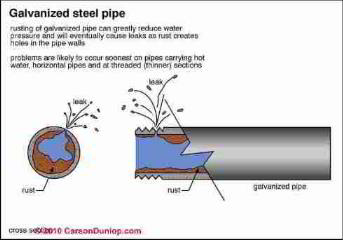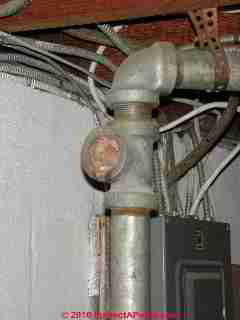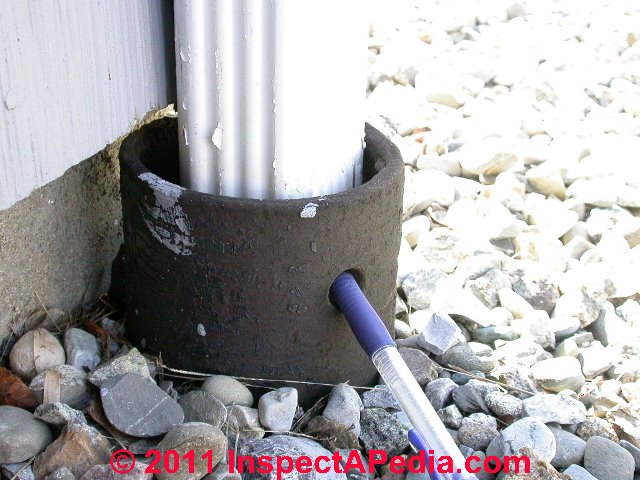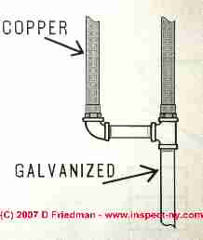 Building Pipe Types & Properties
Building Pipe Types & Properties
Water Supply, Drain Piping & other Pipes in Buildings
- POST a QUESTION or COMMENT about building supply & drain piping
Water supply & drain piping:
Building piping installation, inspection, troubleshooting & repair: water supply piping, drain waste & vent piping, water supply: how to inspect, diagnose, test, repair water supply & drain piping.
This article defines and describes different types of building supply and drain piping with an alphabetical list of piping materials and properties. For each type of building piping material, in addition to giving its description and properties and use, we include special concerns or possible defects to watch-out for.
We will also discuss the life expectancy of lead water piping, the life expectancy of galvanized steel water piping and the life expectancy of copper and plastic water supply and drain piping
The articles at this website will answer most questions about water supply & drain piping, wells, & water tanks as well as many other building plumbing system inspection or defect topics.
We link to in-depth articles on inspecting, testing, and repairing problems with building plumbing: water supply and drain waste vent piping, plumbing traps, piping materials, clogged or noisy pipes, and types of pipe hazards or product defects.
InspectAPedia tolerates no conflicts of interest. We have no relationship with advertisers, products, or services discussed at this website.
- Daniel Friedman, Publisher/Editor/Author - See WHO ARE WE?
Definition & Properties of Types of Building Supply & Drain Piping Materials
This page describes types of building supply and drain piping listed alphabetically.
[Click to enarge any image]
ABS Plastic Building Drain Piping
See ABS PLASTIC PIPE FAILURES for details. Excerpts are below.
In widespread use as drain piping, black ABS drain piping, or "All Black -hit," defective black ABS plastic waste pipe manufactured in the mid 1980's failed by cracking - not something that should be a problem with current ABS products.
Our photo illustrates ABS (black) and PVC (white) drain pipe materials used together. Currently there are primers and glues that can be used on either PVC or ABS or on a combination of the two. [Click to enlarge any image]
But watch out for older installations where these plastic drain materials may be mixed as it may be an indication of amateur work or use of improper glues that can result in leaks at joints and fittings.
Cast Iron Building Drain Piping
See CAST IRON DRAIN PIPING for details. Excerpts are below.
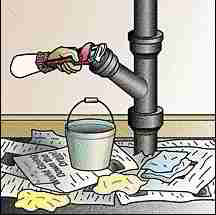
Cast iron drain piping has been used in buildings for more than 100 years. This heavy material is available in diameters from 2" and up, with typical main building drains of 4" to 6" in diameter. A hub system connects pipe sections, originally using melted lead.
The cast iron pipe hub and stub were wiped with oil to remove water, avoiding a dangerous steam flash when lead was poured into the fitting. Most modern cast iron connections are made using rubber or plastic fittings that no longer require heating and melting lead.
The illustrations (left) show accessing a cast iron drain cleanout and two methods of emergency, temporary repair of leaks in drain piping.
Cast iron piping used for in-building drain piping as well as sewer lines is also illustrated at FIND the MAIN BUILDING DRAIN
And at USE a POWER SNAKE to CLEAR a BLOCKED DRAIN you can see a common splice-in of ABS plastic drain piping into an existing cast iron sewer line.
Copper Building Water Supply & Drain Piping
See COPPER PIPING in BUILDINGS for details. Excerpts are below.

Guide to Types of Copper Piping used in buildings
The following summary notes about copper and other types of building piping are from Carson Dunlop Associates' Home Reference Book, used with permission:
Copper piping has been used extensively since the early 1950s for supply lines from the city main to the house as well as for in-building water supply and drain piping.
Copper water supply piping is typically 1/2 or 3/4 inch diameter. Copper piping is typically 1/2 or 3/4 inch diameter. Copper piping has soldered connections and the walls of the pipe are thinner than galvanized steel. Copper piping has soldered connections and the walls of the pipe are thinner than galvanized steel.
From 1950 to 1970, 1/2-inch diameter piping was used commonly. After 1970, 3/4-inch diameter copper service piping has been common.
The life expectancy of copper piping is dependent on water conditions. In many areas, its life expectancy is indefinite. In harsh corrosive water or corrosive soil conditions, it may fail within 20 years or even less. Occasionally manufacturing defects also result in early failure of copper building piping.
Carson Dunlop Associates' sketch (left) illustrates three types of copper piping used in buildings for water supply or drains.
- Type M copper piping is used for general plumbing, above ground. Type M copper tubing walls are the thinnest used in construction, at 0.026" in wall thickness and thus more vulnerable to leaks if water being handled is aggressive or corrosive.
- Type L copper piping is also used for general plumbing as well as for heating system piping. Type L copper tubing walls are thicker, at 0.040".
- Type K copper piping is used for plumbing, heating, gas lines, and underground, and has a wall thickness of 0.049".
- Flexible copper tubing used as water piping: Flexible copper tubing can be bent around corners using special tools. This is not common since it is more expensive and can be awkward to work with in close quarters. Flexible copper tubing is also used for oil piping
See OIL TANK PIPING & PIPING DEFECTS
and for natural gas piping
See GAS PIPING, VALVES, CONTROLS
Galvanized Steel Water Supply Piping in buildings
See GALVANIZED STEEL WATER PIPING for details. Excerpts are below.
Galvanized steel is not commonly used as a service pipe, although galvanized steel fittings may be found at the point of entry into the house. Where galvanized service piping is used, it is typically at least 1 1/4-inch diameter. The word galvanized means zinc-coated.
The coating helps prevent the steel from rusting.
Galvanized steel piping was common until roughly 1950. This piping typically lasts 40 to 60 years. Some lower-quality pipes do not last as long and there are some oversized pipes still in use after 60 years. Where it is found today in single-family homes, it is usually near the end of its life.
Life expectancy of galvanized steel piping: Galvanized steel supply pipes are typically 1/2-inch diameter. The connections are threaded. When the pipe corrodes, the rust accumulation inside the pipe chokes down the diameter of the pipe, resulting in poor water pressure.
Rust also attacks the pipe walls, making the walls thinner. Eventually, the pipe will rust through, usually at the joints first, resulting in leakage.
Sketch above provided by Carson Dunlop Associates, a Toronto home inspeciton and report writing and education company, from their - Home Reference Book, used with permission.
Galvanized Steel Drain Piping in buildings
See GALVANIZED STEEL WATER PIPING
Galvanized "iron" (galvanized steel) pipes were and continue to be used for both water supply pipes and water drain piping. Our photographs (below) show galvanized drain piping in use in buildings.
Above our galvanized dain photo shows that the cleanout in a galvanized drain line has been lost, plugged with who-knows-what, and is an odor and leak source.
Below our photo shows a Sunday Night Emergency Plumbing Repair: the rope trying to secure the galvanized drain line to the cast iron sewer piping confirm a history of leak troubles and improper plumbing connections.
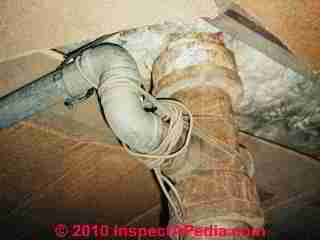
Lead Water Supply & Drain Piping in buildings
See our detailed articles about lead plumbing pipes in buildings at
- LEAD PIPES in BUILDINGS - identification of lead drain or water supply piping, durability, leaks, health questions
- LEAD IN DRINKING WATER, HOW to REDUCE - Lead water supply piping as a possible health concern? Leak concern?
- LEAD in WATER, ACTION LEVELS - Guide to testing for lead contamination caused by water pipes
Portions of the following summary are from Carson Dunlop Associates' Home Reference Book, used with permission:
Lead piping was used between the street main and the house up until the 1950s. A good deal of lead supply line is still in use, and the health authorities indicate that as long as it is used regularly, there is no difficulty with it. If the water has not been run for some time, many recommend that the water be flowed for several minutes before using it.
Our photographs show a lead water supply pipe to a sink (above) and (below) lead plumbing drain piping below a toilet.

The life expectancy of lead water supply piping is indefinite in some soils and in more corrosive soils we have plumbers' opinions that the service life of buried lead water supply piping is 40 to 50 years.
See LEAD WATER PIPES and LEAD in WATER, ACTION LEVELS for details.
Also see AGE of PLUMBING MATERIALS & FIXTURES.
Orangeburg Septic Drainfield Pipes & Area Drainage Pipes
Orangeburg pipes, named not for their color but for the town where the Fibre Conduit Company, a major pipe manufacturer was located, were used outside buildings to connect the building drain to septic systems or in some areas to sewer pipes.
Orangeburg pipes are black, and somewhat fragile bituminous-coated fiber pipes.
See details at ORANGEBURG PIPE
Plastic Building Water Supply Piping & Tubing; Plastic Drain Pipes: ABS, PBS, PEX, CPVC pipes
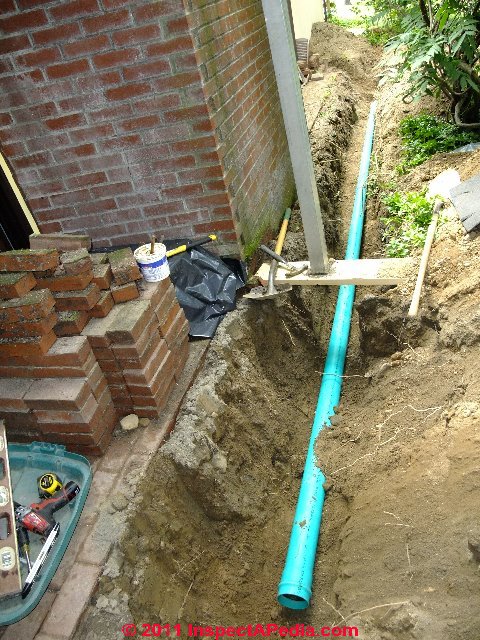
See PLASTIC PIPING ABS CPVC PB PEX PPR PVC or the specific article links just below for details about plastic drain and supply piping in buildings, including its history, failures, warranty claims, class actions, and present usage in construction.
Photo above: PVC drain piping being installed at the author's home.
- ABS PLASTIC PIPE FAILURES
- CROSS-LINKED POLYETHYLENE (PEX) PIPE
- CPVC CHLORINATED POLYVINYL CHLORIDE PIPE
- PB POLYBUTYLENE PIPE FAILURE CLAIMS
- PLASTIC PIPING ABS CPVC PB PEX PPR PVC - all types
- POLYBUTYLENE (PB) PLUMBING PLASTIC PIPES
Plastic water service piping may be polybutylene (PB), polyethylene (PE), cross-linked and Tubing Tubing Tubing Tubing Tubing Tubing Tubing polyethylene (PEX), polyvinyl chloride (PVC) or chlorinated polyvinyl chloride (CPVC).
Most plastic piping is buried at least 18 inches deep. Exposed piping may be subject to mechanical damage and deterioration from sunlight. - Home Reference Book, used with permission.
See DRAIN LINE DEPTH for details about the proper depth for buried drains.
Terra Cotta Pipes at buildings - Clay Drain Pipes: definition, properties

Terra cotta pipes are clay pipe that was used for external sewer (or septic system) connection in North America from about 1900 to 1940.
Terra cotta pipe is often deep red to orange in color, round with hubs to facilitate pipe section connections. (Photo, above left).
In smaller sizes terra cotta may be hexagonal in external shape (photo above right) though round in its interior profile. Joints in terra cotta piping were made using cement to surround the piping.
The material was both durable (it does not corrode or rot) but fragile, easily broken by heavy traffic above or by improper bedding in the trench if exposed to heavy rocks.
Clay drainfield piping or "drain tiles" is also SHOWN IN FRAGMENTS [Image file] in our article on sewer line replacement,
at DETERMINE NEED for DRAIN LINE REPLACEMENT.
We also provide this photo of another type
of OCTAGONAL CLAY SEWER AND SEPTIC PIPING [Image file] that was often used in drainfields as disjointed sections.
...
Reader Comments, Questions & Answers About The Article Above
Below you will find questions and answers previously posted on this page at its page bottom reader comment box.
Reader Q&A - also see RECOMMENDED ARTICLES & FAQs
On 2020-08-29 by Linda Trimm - Ceramic pipe mistaken for antique pottery?
Thank you so much shooting holes though my "I found archaic clay pottery" fantasy.
lol While digging up a hackberry tree's roots I found exactly what you have in your Terra Cotta pipe photo. This house and neighborhood was built in the 1950s no idea what this pipe went to.
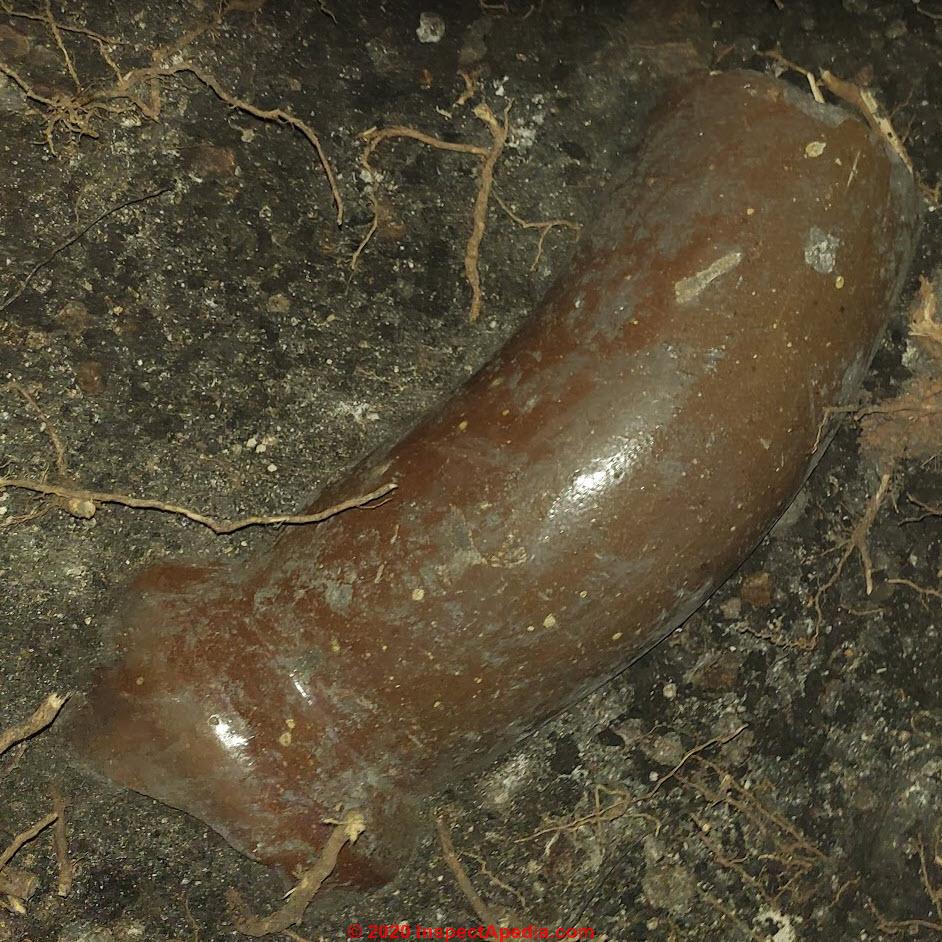
On 2020-08-29 by (mod)
Thank you for the excellent clay pipe photo, Linda.
On 2018-06-13 by GDK
I'm running underground water line to a new home 600' across my property. Are there any rules as to what type of pipe has to be used for tying into the home?
On 2018-06-14 by (mod)
I think that running piping underground you probably want a plastic pipe rated for potable water. That avoids issues of corrosion.
https://inspectapedia.com/plumbing/Plastic_Pipes.php
On 2016-12-17 by Anonymous
I live on the first floor of a three story condominium. The kitchen sink backed up and overflowed while I was at work.
The plumber said he broke the clog about 20'-30' down the pipe. The management company says "it's grey water and doesn't need to be treated as raw sewage". Is the clean up for this any different than a clean up for any other sewage back up?
Only getting water towards back of house, but no hot water anywhere on house
I meant to say that if the sewer line that backed up also contained black water or sewage from toilets that flush into the same drain line then in fact it's possible depending on just what water spilled that disinfection and sewage cleanup would indeed be appropriate.
Sink drainage is greater, but if the sewer line
Question: what's the right type of copper pipe to use at my urinals?
Inspector is challenging me about the type of copper pipe installed for waste pipe on my urinals. I installed DWV Copper tube and he says type m is minimum. What do you say I cannot find anything in ontario plumbing code 2006. - Karac Rushton - 6/29/2012
Reply: 2007 Ontario Plumbing code permits K & L copper; M above ground; DWV above ground but not buried.
Karac, the 2007 Ontario Plumbing code is available online at opseu560[dot]org/BuildingCode-2007[dot]pdf
and section 7 discusses plumbing.
There are some additional standards that apply:7.2.2.2. Conformance to [Plumbing] Standards
(1) Every water closet and urinal shall conform to the requirements in Article 7.6.4.2.
(2) Every vitreous china fixture shall conform to CAN/CSA-B45.1, "Ceramic Plumbing Fixtures".
(3) Every enameled cast iron fixture shall conform to CAN/CSA-B45.2, "Enamelled Cast Iron Plumbing Fixtures".
(4) Every porcelain enamelled steel fixture shall conform to CAN/CSA-B45.3, "Porcelain- Enamelled Steel Plumbing Fixtures".
Copper pipe shall conform to ASTM B42, "Seamless Copper Pipe, Standard Sizes".
That code includes a table of allowed uses of copper. Table 7.2.7.4. - Permitted Use of Copper Tube and Pipe Forming Part of Sentence 7.2.7.4.(2)
In the table, if I read it correctly it says that the drainage system piping can use K & L hard copper, and M-hard above ground but not buried, and DWV above ground but not underground.
So if all your DWV is above ground, by that table you're in compliance. You can show the table to your building inspector, and if you are polite you might get somewhere.
Don't forget that the local code compliance inspector has FINAL AUTHORITY.
...
Continue reading at ABS PLASTIC PIPE FAILURES or select a topic from the closely-related articles below, or see the complete ARTICLE INDEX.
Or see Drain waste and vent piping articles DRAIN & SEWER PIPING
PLUMBING VENT DEFECTS & NOISES
Or see these
Building Piping Articles
- CLOGGED DRAIN DIAGNOSIS & REPAIR
- CLOGGED SUPPLY PIPES, DIAGNOSIS
- CLOGGED SUPPLY PIPES, HOT WATER
- CONDENSATE RETURN PIPES, PUMPS, STEAM
- CONDENSATION or SWEATING PIPES, TANKS
- DIAELECTRIC PIPE FITTINGS
- DRAIN & SEWER PIPING - home
- LEAD PIPES in BUILDINGS
- LEAK CAUSES in WATER PIPING
- ODORS, DRAIN & SEWER LINE SOURCES
- PIPING in BUILDINGS, CLOGS, LEAKS, TYPES - home
- PLUMBING NOISES
- PLUMBING VENT PIPING - home
- SEWER LINE LEAKS & ODORS
- SOUND CONTROL for PLUMBING
- SUPPLY PIPING - home
- WATER HAMMER NOISE DIAGNOSE & CURE
- WATER PIPE CLOG DIAGNOSIS
- WATER SUPPLY - home
- WINTERIZE A BUILDING
Suggested citation for this web page
PIPING in BUILDINGS, CLOGS, LEAKS, TYPES at InspectApedia.com - online encyclopedia of building & environmental inspection, testing, diagnosis, repair, & problem prevention advice.
Or see this
INDEX to RELATED ARTICLES: ARTICLE I NDEX to PLUMBING SYSTEMS
Or use the SEARCH BOX found below to Ask a Question or Search InspectApedia
Ask a Question or Search InspectApedia
Try the search box just below, or if you prefer, post a question or comment in the Comments box below and we will respond promptly.
Search the InspectApedia website
Note: appearance of your Comment below may be delayed: if your comment contains an image, photograph, web link, or text that looks to the software as if it might be a web link, your posting will appear after it has been approved by a moderator. Apologies for the delay.
Only one image can be added per comment but you can post as many comments, and therefore images, as you like.
You will not receive a notification when a response to your question has been posted.
Please bookmark this page to make it easy for you to check back for our response.
IF above you see "Comment Form is loading comments..." then COMMENT BOX - countable.ca / bawkbox.com IS NOT WORKING.
In any case you are welcome to send an email directly to us at InspectApedia.com at editor@inspectApedia.com
We'll reply to you directly. Please help us help you by noting, in your email, the URL of the InspectApedia page where you wanted to comment.
Citations & References
In addition to any citations in the article above, a full list is available on request.
- John Cranor [Website: /www.house-whisperer.com ] is an ASHI member and a home inspector (The House Whisperer) is located in Glen Allen, VA 23060. He is also a contributor to InspectApedia.com in several technical areas such as plumbing and appliances (dryer vents). Contact Mr. Cranor at 804-873-8534 or by Email: johncranor@verizon.net
- Mark Cramer Inspection Services Mark Cramer, Tampa Florida, Mr. Cramer is a past president of ASHI, the American Society of Home Inspectors and is a Florida home inspector and home inspection educator. Contact Mark Cramer at: 727-595-4211 mark@BestTampaInspector.com 11/06
- Eric Galow, Galow Homes, Lagrangeville, NY. Mr. Galow can be reached by email: ericgalow@gmail.com or by telephone: 914-474-6613. Mr. Galow specializes in residential construction including both new homes and repairs, renovations, and additions.
- Roger Hankey is principal of Hankey and Brown Inspections, Winter Park, CO. Mr. Hankey is a past chairman of the ASHI Standards Committee and served in other ASHI chapter and national leadership roles. Mr. Hankey is a National Radon Proficiency Program certified measurement professional and a Level II infrared thermographer. Contact Roger Hankey at: 970-393-6604 - rogerhankey47@gmail.com . Website: www.HankeyandBrown.com Mr. Hankey is a frequent contributor to InspectAPedia.com.
- ABS Plastic Drain/Waste/Vent (DWV) pipe failures: reported for Centaur, Phoenix, Polaris, Gable, and Spartan pipe mfgs. for pipe made between 1985 and 1988. CPSC Hot Line: 800-638-8270 or ABS Drain Leaks/Failures-Class Action Settlement COX settlement through Shell Oil set up by a contractor involved in the settlement. Polybutylene Plumbing Failures: Spencer Class settlement, Web: spencerclass.com, 10% of replacement cost/damages, only for acetal (plastic)fittings Polybutylene piping lawsuit settlement website Polybutylene plumbing lawsuit proposed settlement-old site
- In addition to citations & references found in this article, see the research citations given at the end of the related articles found at our suggested
CONTINUE READING or RECOMMENDED ARTICLES.
- Carson, Dunlop & Associates Ltd., 120 Carlton Street Suite 407, Toronto ON M5A 4K2. Tel: (416) 964-9415 1-800-268-7070 Email: info@carsondunlop.com. Alan Carson is a past president of ASHI, the American Society of Home Inspectors.
Thanks to Alan Carson and Bob Dunlop, for permission for InspectAPedia to use text excerpts from The HOME REFERENCE BOOK - the Encyclopedia of Homes and to use illustrations from The ILLUSTRATED HOME .
Carson Dunlop Associates provides extensive home inspection education and report writing material. In gratitude we provide links to tsome Carson Dunlop Associates products and services.


